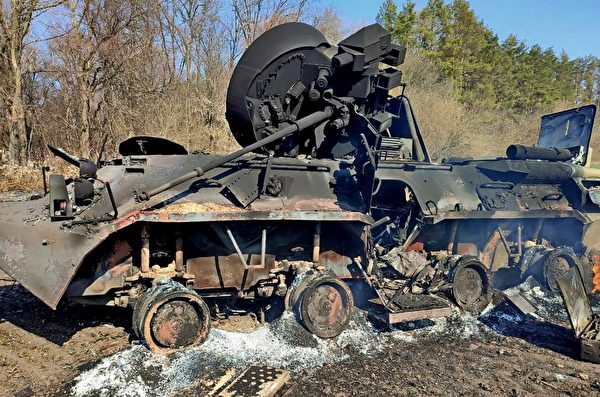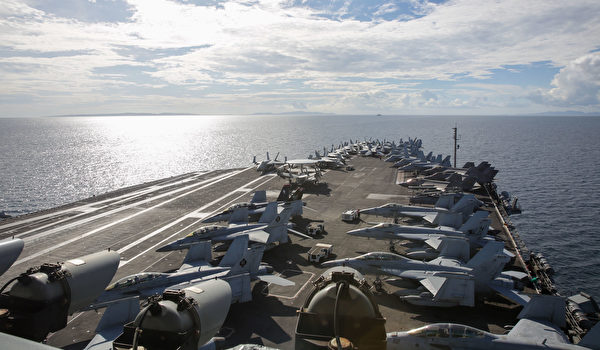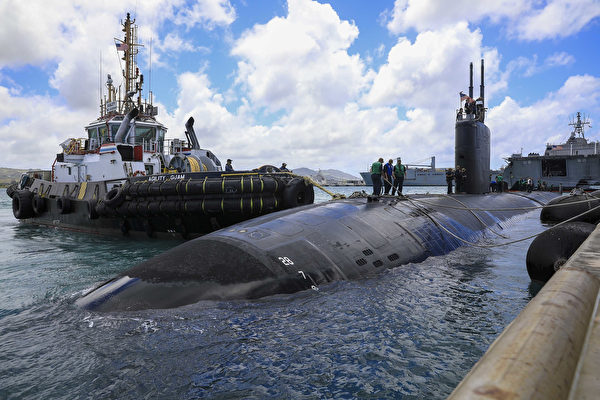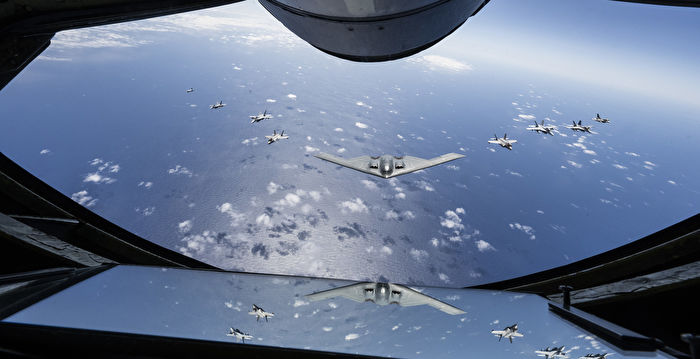[The Epoch Times, March 27, 2022]A month after the Russian invasion of Ukraine, it was difficult to achieve its goals and had to claim to focus on the Donbas region in eastern Ukraine. However, it seems that it is not easy for the Russian army, which has penetrated into multiple fronts in Ukraine, to escape. The United States and NATO should not plan to give the Russian army a step to exit with dignity. At the same time, the United States warned the CCP not to try to intervene, and the U.S. B-2 bomber was dispatched to escalate its deterrence in the Pacific Ocean, warning the CCP of the possible consequences if it did not heed the warning.
NATO does not want to let go of the Russian army
On March 25, the US Department of Defense issued a press release, “In Ukraine, Russian Activity Now More Focused on Donbas Than Kyiv.”
The article inserts a map of Ukraine, but it does not show any Russian forces in Kyiv, the second largest city Kharkov, and the southern region. Only the Donbas region in eastern Ukraine is marked in different colors. This is more like the situation map of the next stage determined by the US military, that is, the Russian army is forced to withdraw from most of the currently occupied Ukraine areas, and the war may eventually become a tug-of-war in the Donbass.
If the Russian army ends like this, it is obviously not decent, and NATO has not shown any intention to directly participate in the negotiations. The signal from the special NATO summit on March 24 is that if the Russian army does not stop fire and withdraw, Russia will continue to pay the price and be held accountable for the war.
NATO suspects that the Russian army may use biological and chemical weapons in order to break the deadlock.
If the Russian army uses biological and chemical weapons, or even nuclear weapons, it is equivalent to giving NATO an excuse to participate in the war. 100,000 U.S. troops and 40,000 NATO troops are waiting in battle. Once attacked, the tens of thousands of Russian troops fighting hard in Ukraine may be at risk of being eaten. It cannot be ruled out that NATO will take advantage of the situation to counterattack Russia, and the Russian troops, which have lost part of their main force, will fall into a strategic passive . If the Far East changes again, Russia will be the enemy.
The Russian army should have assessed the possible risks and had to take the initiative to say that it turned to eastern Ukraine, which seemed to signal a strategic retreat.
Give up attacking places like Kyiv?
The U.S. Department of Defense assesses that Russian airstrikes are still ongoing in Kyiv, but it appears to be less interested in ground operations than in the past.
The think tank ISW commented that the Russian army falsely claimed on March 25 that it had completed the “main tasks of the first phase of the operation” and falsely claimed that Russia had severely weakened the Ukrainian army. The Kremlin’s initial operations were aimed at conducting airborne and mechanized operations to capture Kyiv, Kharkov, Odessa and other major Ukrainian cities, forcing a change in the Ukrainian government. There are currently no major offensive operations by the Russian army in most of Ukraine, which may reflect the inability of the Russian army to generate enough combat power to attack; any decision by Moscow to change the goal of the war or focus on the east may try to hide the failure from the domestic population . Russian forces may have scaled back their targets, but elsewhere in Ukraine they have not completely stopped advancing.
The think tank ISW believes that Russian propaganda should not be taken for granted, the Russian military is still trying to rebuild its combat effectiveness, is committed to encircling or attacking Kyiv and occupying Malibo and other targets, and is building a joint force, which may be composed of individuals or small units from different units , to compensate for combat losses.
The U.S. Department of Defense also analyzed that the Russian military seems to be mobilizing its troops in Georgia to participate in operations in Ukraine; it is also trying to mobilize troops from Georgia.
It is not ruled out that the Russian army will use blindfolding again, while pretending to cool down, trying to paralyze the Ukrainian army, lure the Ukrainian army into a large-scale attack, and then seek an opportunity for a decisive battle. This depends on whether the Ukrainian military continues to receive accurate information, and on the existing combat capabilities of both sides.

Russian-Ukrainian Army Battle Damage Assessment
On March 25, the Russian Defense Ministry said 14,000 Ukrainian soldiers were killed and 16,000 wounded. Such a figure is more like an estimate, and the ratio of deaths and injuries is not logical. A more reasonable ratio of deaths and injuries should be 1:2, 1:3 or 1:4.
According to the figures claimed by the Russian army, the Ukrainian army killed and wounded a total of 30,000 people, and the Ukrainian regular army was about 200,000 people, accounting for 15%. If you count the rapidly recruited Ukrainian military personnel, the original paramilitary personnel, hundreds of thousands of Ukrainians returning from abroad, and tens of thousands of foreign soldiers, even if the number of Ukrainian troops killed and wounded announced by the Russian army is exaggerated, the proportion is still high. It is not big, but it proves that the Ukrainian army did not suffer heavy casualties. The Russian army also stated that “the combat potential of the Ukrainian armed forces has been greatly weakened”, and did not claim to have eliminated or routed the main force of the Ukrainian army.
The Russians claimed 1,351 killed and 3,825 wounded; but NATO estimates that 7,000 to 15,000 Russians were killed and 30,000 to 40,000 wounded. The latest assessment by the U.S. Department of Defense puts the available combat effectiveness of the Russian military at between 85% and less than 90%. Based on the Russian army’s 200,000 invading troops, the combat attrition should be 20,000 to 30,000.
The actual casualties of the Russian army may exceed that of the Ukrainian army, which is consistent with the fact that the Russian army has been repeatedly ambushed. The figures released by the Russian army also confirm that the Russian army has never been able to find the trace of the main Ukrainian troops.
If the two sides start a large-scale confrontation, the Russian army’s long-range firepower and armored forces should have a greater advantage; but the Ukrainian army unexpectedly ambushed and counterattacked with a small force, eliminating the Russian army’s advantage in close combat after another, and played a counter-attack. The power of tank weapons.

The Russian Army Can’t Fight the War of Attrition
The U.S. Department of Defense said that the Russian military launched more than 1,250 missiles, and air strikes, bombing and long-range strikes continued, but some missiles, especially cruise missiles, had malfunctioned and either failed to launch or failed to hit their targets; the Russian military Missile stocks may still exceed 50%, with air-launched cruise missiles being the lowest; precision-guided munition stocks are beginning to decline, and unguided bombs are increasingly being used.
The US Department of Defense assessed that the Russian military is currently in a defensive posture. They overestimated the ability to occupy Kyiv, overestimated the ability to occupy any population center, and underestimated the resistance of Ukraine. The Russian army continues to consume resources and see no sign of trying to bring in supplies from elsewhere.
In contrast, the West has continuously provided weapons and supplies to the Ukrainian army, which the Russian army is powerless to stop. On March 24, the large Russian landing ship “Orsk” was sunk; it was impossible to confirm which troops used what weapons, but Russian supply lines in the Black Sea were no longer safe. The long-term war of attrition is probably one of the prices that NATO wants Russia to pay. Russia, which is under economic sanctions, cannot maintain a long-term siege and continuous large-scale bombing.
On March 25, British Ministry of Defense intelligence showed that Ukrainian forces had retaken towns and defensive positions on the eastern outskirts of Kyiv in a counterattack.
If the Ukrainian army continues to counterattack and ambushes on a small scale, and the Russian army does not have the ability to maneuver on a large scale, the troops and supplies will be tight, and the strategy of besieging Kyiv and other large cities will become difficult to implement. The Russian army may have to face the conundrum whether it can safely withdraw from multiple fronts, retreat eastward or toward Belarus, or continue to try to occupy the southern part of the coast.
It is unlikely that the Russian army will leave the field with dignity, and the question is how many casualties will be. If the U.S. military really assists Ukraine’s anti-ship missiles, the Russian military’s intention to control the Black Sea may also be in vain.

The US military warns the CCP: only by the sidelines
On March 18, Biden called Xi Jinping and directly warned against aid to Russia. On March 20, the US Indo-Pacific Commander flew over the South China Sea in a P8-A patrol aircraft.
On March 23, the US military announced that the B-2 bomber appeared in Australia for a joint exercise with the Australian Air Force, and the Indo-Pacific Commander was present again. The U.S. military has used Australia as a forward base for B-2 bombers, avoiding Guam, which could be hit by a Chinese DF-26 missile. If the U.S. military uses B-2 bombers, it is probably not for air strikes on the islands and reefs of the South China Sea or the CCP’s coastal military bases, but more likely for the CCP’s missile bases in the inland, or even beheadings. The U.S. military has raised its deterrence level at this time, and it is also warning the CCP that whether it takes risks in the Taiwan Strait or supports Russia, the consequences will be quite serious.
The deterrent effect is obvious. On March 24, the spokesperson of the Ministry of National Defense of the Communist Party of China specifically answered the Ukraine question, first saying that Russia invaded Ukraine and that China’s “prior knowledge, acquiescence, connivance and other claims are completely false information”; also that China’s “providing military assistance to Russia is completely false information.” “; and then “always pursue a defensive national defense policy and a military strategy of active defense”, “never engage in proxy wars, never seek spheres of influence, and never participate in military group confrontation.”

The Chinese military should not only see the B-2 bomber dispatched. On March 22, the U.S. military released a picture of the USS Lincoln (CVN72) passing through the Strait of the Philippine Islands, which should be entering the South China Sea from the Philippine Sea. Recently, the U.S. submarine also deliberately appeared; the commander of the U.S. Indo-Pacific Air Force also revealed that the F-35 fighter jet and the Chinese J-20 met in the East China Sea.

From March 28 to April 8, approximately 8,900 U.S. and Philippine troops will participate in the Balikatan 2022 exercise, which includes maritime security, amphibious operations, live-fire training, urban operations, aviation operations, counterterrorism and disaster relief. This is a rare large-scale exercise between the United States and the Philippines in recent years. I wonder if the outbreak of the Russian-Ukrainian war has made the Philippines alert again.
On March 24, the NATO special summit statement demanded that China “do not support Russia’s war in any way” and “avoid any action that would help Russia to evade sanctions.” It also called on China to “stop amplifying the false narrative of the Kremlin, especially A false narrative about war and NATO.”
While the United States and NATO are targeting Russia, they are also targeting the CCP. The dilemma of the Russian army has also put the CCP in a dilemma.
Short video: US B-2 bombers operate at the Australian Air Force Base. (Australian Air Force)
The Epoch Times premieres
Responsible editor: Gao Yi #
